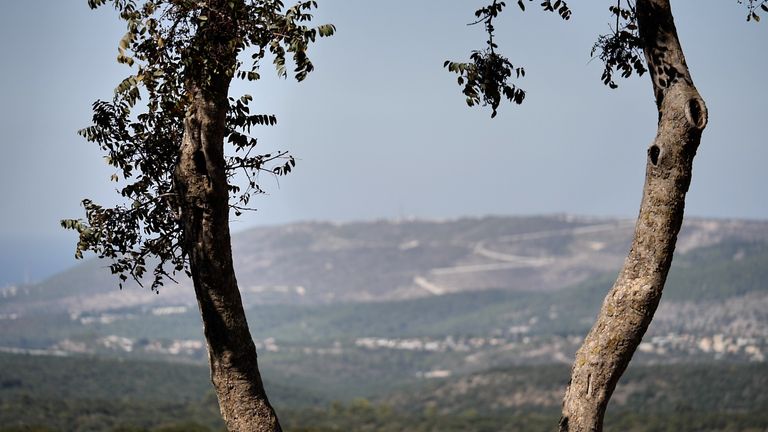Below us the sea shines. The sun is out and we have a perfect view of the coast.
It could be a lovely place, but instead we’ll be diving for cover in a few minutes.
Welcome to the border between Israel and Lebanon.
We came here accompanied by the Israeli army, wanting to show the control they have over the area and also, I would discover, to express their anger at the United Nations (UN).
But also to satisfy our curiosity – what exactly is it like on this border, through which so many rockets, missiles and drones fly every day?
Here we are, on the dividing line between the two nations.
From where I stand, I can look to my right and see the boundary wall rising on top of the ridge. There is an Israeli army base ahead that has been hit several times Hezbollah rockets.
And then to my left, maybe 100 meters down the road is the official border crossing where tourists crossed from one side to the other. It is now open for UN staff to pass through.
“A high price for war”
There are no tourists here now. In fact, apart from soldiers, we haven’t seen anyone for some time.
About 60,000 Israelis have either been evacuated or fled this region.
The goal of Israel’s campaign in southern Lebanon, says Lt. Col. Jordan Herzberg, an operations officer with the Army’s 146th Division, is simple — to ensure that these people “can go back home and live in safety and security.”
“These people have paid a very high price for the war,” he says.
“The economy here is all about agriculture and tourism, and both don’t exist. They were targeted with hundreds of anti-tank missiles – you might call them anti-home missiles. They’re hitting people’s homes — the homes of normal civilians.”
Across the road, a cafe sits idle and no one looks at the explanatory map. The cable car that normally takes visitors down to see caves and British-built railway tunnels is not working.
On the other side of the wall, Israel conducts its ground campaign, going from house to house, pushing its troops several miles into Lebanon.
They say they found a huge stockpile of weapons and ammunition – enough, they say, for Hezbollah to launch a wide-scale attack on the civilian population that could have been even more devastating than the October 7 attack by Hamas.
The Israelis support their army by regularly shelling Lebanese territory. As we stand on the border, we can see smoke rising into the air from the ridge.
“This is the sound of freedom”
We’re just about to leave when there’s a sudden, urgent call to take cover. We shelter behind a wall, listening through the sudden silence. A soldier tells me they spotted a UAV – a drone.
“It can be very dangerous,” she says.
A few minutes pass and then we’re told it’s safe, but it’s also time to go. As we move away, we see the cloud of smoke in the air where the drone was intercepted and destroyed.
A few miles from the border we watch the smoke rise into the sky. There is a loud boom as another shell is fired into Lebanon.
“This is the sound of freedom,” said Lt. Col. Hertzberg.
But this, he insists, is a war that should never have happened, and he blames the UN. For almost two decades, since the war ended in 2006, UN peacekeepers have been stationed here and Lieutenant Colonel Herzberg insists they have not done their job.
“If they had done their job, we wouldn’t be fighting”
Resolution 1701, under which Israel and Lebanon agreed to a ceasefire, called for all armed groups to be removed from an area between the border and the Litani River, nearly 20 miles away.
It never actually happened. Hezbollah has built tunnels and brought in weapons and men.
“The UN has been here since 2006 and their mandate is to prevent any armed groups in southern Lebanon other than the Lebanese Armed Forces,” Lt. Col. Herzberg told me.
“It is clear that they did not do this because we are fighting the armed forces of Hezbollah in southern Lebanon. We discovered some of Hezbollah’s positions literally under the noses of UN bases.
“What have they been doing for the last eighteen years? If they had done their job, we wouldn’t be fighting this war.”
Candace Ardiel is the deputy spokesperson for UNIFIL, the United Nations force in Lebanon. She told me that it was clear that the truce had not been fulfilled.
“We have never denied that there are problems and that is why the mission continues to be here. We are constantly noting and monitoring the spread,” she said.
Read more:
Palestinians blindfolded and taken away by Israeli soldiers
Dozens of Israelis plan to cross the border and settle in Gaza
“We saw videos, including one from a tunnel a few hundred meters from one of our positions in Lebanon. But we are here at the invitation of the Lebanese government, so we have to ask the Lebanese army to facilitate our access. Peacekeepers cannot go alone on private property and that permission was never given.
“Peacekeeping is a challenge. None of these countries were fully committed to Resolution 1701. We saw that from the beginning, and what we’re seeing now is the result of that lack of trust.”






